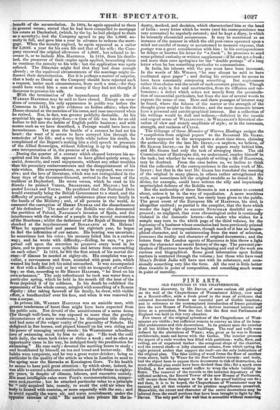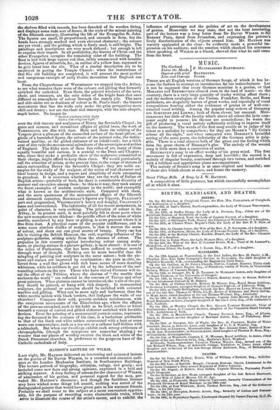FINE ARTS.
OLD PAINTINGS IN THE CHAPTERHOUSE.
THE recent discovery, by Mr. DEVON, of some curious old paintings on the wall of the Chapterhouse of Westminster Abbey, now used as a Record-office, adds a fresh proof to the mass of evidence that coloured decorations formed an essential part of Gothic interiors ; and in reference to the contemplated introduction of fresco paintings into the new Houses of Parliament, it derives increased interest and force as a precedent, from the fact that the first real Parliament of England was held in this very chamber.
Few traces of the original splendour of the Chapterhouse of West- minster are visible ; but sufficient remain to convey an idea of its beau- tiful architecture and rich decorations. In its present state the exterior is all but hidden by the adjacent buildings. The roof and walls were defaced by the alterations of WREN; who, great as be was in Roman architecture, made sad havoc with the Gothic. The interior presents the aspect of a rude wooden box filled with partitions : walls, floor, anti ceiling, are of unpainted timber : the octagonal shape of the chamber, and the central shaft—a lofty clustered column, from which spring the eight pointed, arches that support the roof—are the only indications of the original plan. The false ceiling of wood forms the floor of another room above, built by WREN for the Star-Chamber records : and truly, had the object been to expose those documents to risk of destruction, no more effectual plan could have been devised than this ; for a spark once kindled, a few minutes would suffice to wrap the whole building in flame. The removal of the records to the intended depository of the national archives, the Record Tower of the new Houses of Parliament, secure them from danger as far as a fire-proof building can do; and then, it is to be hoped, the Chapterhouse of Westminster may be uncased, and all that remains of its pristine magnificence preserved. Meanwhile, the extent and character of the entire decorations may be inferred from the small portions that have been brought to light by Mr. DEVON. The only part of the wall that is accessible without removing the shelves filled with records, has been denuded of its wooden lining, and displays some rude sort of fresco, it the style of the missal-painting of the fifteenth century, illustrating the life of the Evangelist St. John. The figures are small, ill-proportioned, and uncouth in form, but the heads have strongly marked and even elevated character ; the colours are yet vivid ; and the gilding, which is freely used, is still bright. The paintings and inscriptions are very much defaced ; but enough is left to express their import. In all probability, the history of Christ and the other Evangelists occupies the remaining sides of the building. The floor is laid with large square red tiles, richly ornamented with heraldic devices, figures of minstrels, &c., in outline of a yellow hue, supposed to be gold burnt into the tile. Tiles of a similar description are to be employed in paving the Temple Church : when the restorations of that fine old building are completed, it will present the most perfect and sumptuous example of early Gothic decoration that England can boast.
From the Chapterhouse of Westminster we stepped into the Abbey, to see what remains there were of the colours and gilding that formerly enriched the cathedral. Even there, the painted windows of the nave, choir, and transepts, are the only relics of the bright hues that once diffused an atmosphere of colour through the stately pile. The nave and side-aisles are as destitute of colour as St. Paul's itself: the bizarre monuments that line the walls only make the grim perspective more chill and dreary ; nor are the choir and transepts, with the side-chapels, mach better. No longer do
•• Storied windows richly dight Cast a dim religious tight 's
over the rich tracery and sculptures of Henry the Seventh's Chapel; its pies and screens, and recumbent effigies of gilded brass, the work of TORRIGIANO, are dim with dust. Here and there the rubbing of the Vergers gives a glimpse of the enamelled surface of the head-pillow, or girdle of a burnished figure, the colours of the painted robe, the richly- veined marbles, or the gilded alabaster of an inlaid tomb ; but a thick coat of dirt veils the monumental splendours of the sovereigns and nobles of England. The filthy state of these fine relics of art, many of them equally: beautiful and curious, is a scandal to the Dean and Chapter ; who, since they make a profitable show of the sculptures committed to their charge, might afford to keep them clean. We would particularly call the attention of artists, at the present time, to the range of statues of saints surrounding Henry the Seventh's Chapel : they are noble ex- amples for the study of the sculptor, of the union of real character and ideal beauty in design, and a repose and simplicity of style amounting to grandeur. It is uncertain whether they are the work of Italian or English artists—probably of both, for there is considerable diversity of manner and execution among them : be this as it may, they rank among the finest examples of modern sculpture in the world; and exemplify what is known as the architectonic style. Compared with them, and the stern quaintness of the monumental effigies of the fifteenth and sixteenth centuries, ROURILIAC'S figures are frippery, FLAXBIAN'S pert and pragmatical, Wnermacorr's heavy and doughy, CHANTREY'S tame and conventional. The inferiority of all the recent monuments, in point of character, is very striking. The privation of colour in the Abbey, in its present state, is most painfully felt in those parts where the new monuments are thickest : the petrific effect of the mass of white marble, unrelieved by any hues or gilding, is even greatest where it is free from dust. A principal cause of the popular indifference, and in some cases absolute dislike of sculpture, is that it starves the sense of colour, and shuts out one great source of beauty. Every cue has felt in visiting the British Museum, the cold, repelling influence of the sculpture-galleries, arising solely from the absence of colour. The prejudice in this country against introducing colour among sculp- tures, or placing statues in a picture-gallery, is most absurd : it is one of the relics of Puritanism, that has been suffered to continue merely through want of thought. Nothing can be more beautiful than the mingling of painting and sculpture in the same saloon ; both the pic- tures and statues are improved by combination : the pure marble, re- lieved from a wall that glows with rich hues, seems of more dazzling whiteness, while its coldness is got rid of by the influence of the sur- rounding colours on the eye. Those who have visited Florence will re- cal the effect of the Tribune, where the charms of "the marble that enchants the world" are reflected in the canvass of TITIAN and other great painters. When pictures cannot be introduced, the walls of the gal- lery should be painted, or hung with rich drapery. In monumental sculpture, the pedestal or canopies should be enriched with coloured marbles and gilding. What can be more ugly and barbarous than the white marble tablets with black borders, that disfigure the walls of our churches ? Compare their cold, poverty-stricken tastelessness, with the sumptuous monuments of the Elizabethan age, where the effigies of the persons entombed, each in his habit as he lived, recline or kneel beneath a canopy of carved and gilded alabaster enriched with heraldic devices. Even the painting of a monumental portrait-statue, represent- ing the deceased in the costume of his time, is a barbarism preferable to that of the black and white tablets surmounted with a bust or some worn-out commonplace, such as a tea-urn or a cellaret half-hidden with a tablecloth. But when our dwellings exhibit such strong evidences of chromaphobia, (though the symptoms are somewhat abating,) no wonder that our places of worship emulate the black and white of the Dutch Protestant churches, in preference to the gorgeous hues of the Catholic cathedrals of Italy.



























 Previous page
Previous page